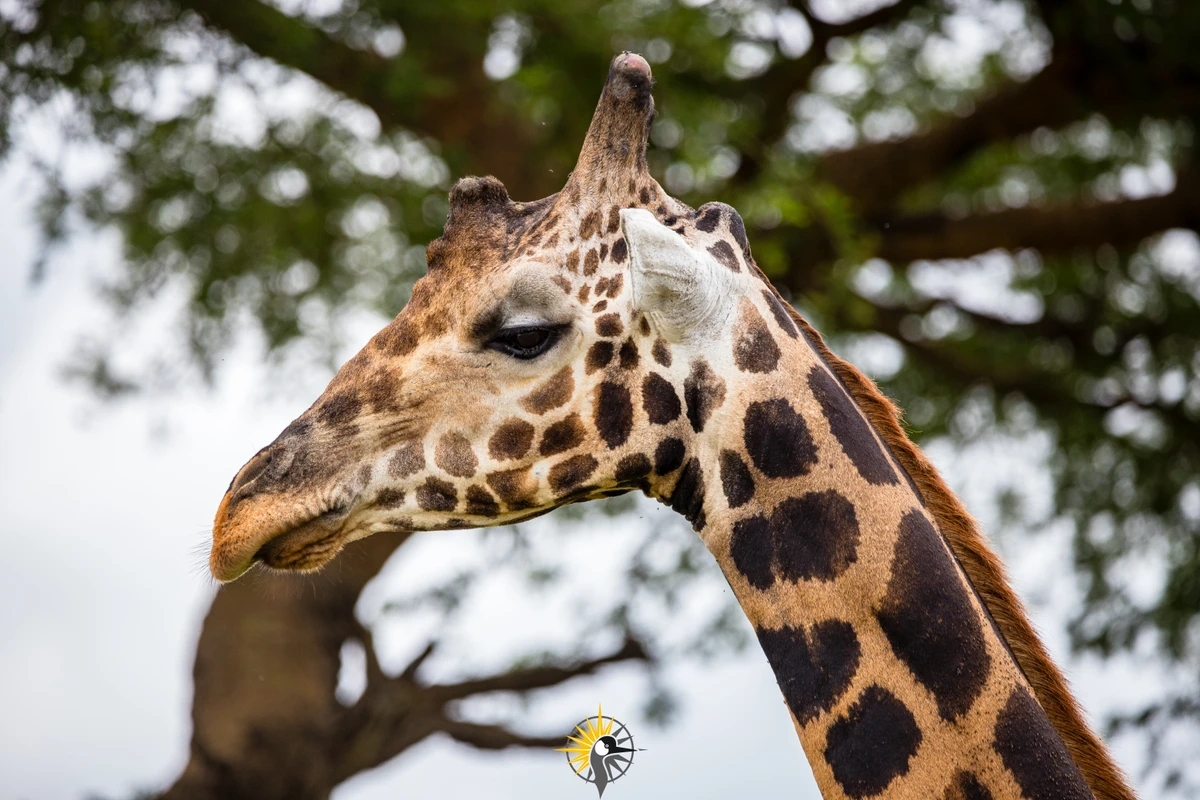The giraffe, scientifically known as Giraffa camelopardalis, is an iconic African herbivore famous for its towering height, unique spotted coat, and gentle demeanor. Known as the tallest land animal on Earth, giraffes are a captivating species that hold the fascination of wildlife enthusiasts, photographers, and tourists alike. Here's a detailed exploration of these magnificent creatures:
Physical characteristics
Giraffes are easily recognized by their long necks, which can measure up to 6 feet (1.8 meters) and contain only seven vertebrae, the same number as in a human neck but much larger. Their height, reaching up to 18 feet (5.5 meters) in males, allows them to access foliage high up in acacia trees, a favorite food source. Their prehensile tongues, which can be up to 20 inches (50 cm) long, help them pluck leaves from thorny branches with ease.
The giraffe’s coat features unique patterns of patches that vary by subspecies, with no two individuals having the same pattern. These markings serve as camouflage, blending into the dappled light of their savanna habitats.
Habitat and distribution
Giraffes are native to sub-Saharan Africa, inhabiting savannas, grasslands, and open woodlands. They are most commonly found in countries like Kenya, Tanzania, Botswana, and South Africa. Some subspecies, like the Rothschild’s giraffe, can also be spotted in Uganda, particularly in Murchison Falls National Park and Kidepo Valley National Park.
Diet and behavior
Primarily browsers, giraffes feed on a diet of leaves, flowers, and fruits, consuming up to 75 pounds (34 kg) of vegetation daily. Their height and elongated necks grant them access to food unavailable to most other herbivores. Interestingly, their digestive systems are highly efficient, enabling them to extract maximum nutrients from their plant-based diet.
Despite their calm and docile appearance, giraffes are vigilant creatures. They rely on their excellent vision to detect predators from afar, often serving as sentinels for other animals. When threatened, they can defend themselves with powerful kicks capable of injuring or killing a lion.
Social structure
Giraffes are social animals, often seen in loose herds that vary in size. These herds are fluid, with individuals coming and going. Males establish dominance through a behavior known as "necking," where they swing their necks to deliver powerful blows to each other. The winner gains access to females for mating.
Conservation status
Giraffes are currently listed as vulnerable by the International Union for Conservation of Nature (IUCN). Habitat loss, poaching, and human-wildlife conflict are significant threats to their survival. Conservation efforts are underway, including habitat protection and anti-poaching initiatives, to ensure their long-term survival.
Cultural significance
Giraffes have long been celebrated in African folklore and art, symbolizing grace, elegance, and the connection between Earth and sky due to their towering stature. They also play a role in tourism, drawing visitors to African savannas and boosting local economies.
Experience giraffes in the wild
For those eager to see giraffes in their natural habitat, safaris in Africa’s iconic parks and reserves provide unforgettable encounters. Parks like Serengeti National Park in Tanzania, Maasai Mara in Kenya, and Murchison Falls National Park in Uganda are prime locations to witness these animals against the breathtaking backdrop of the African wilderness.
Would you like me to expand on giraffes in a specific context, such as their role in eco-tourism or their unique adaptations?
Where to Find Giraffes in East Africa
East Africa is one of the best regions in the world to observe giraffes in their natural habitat. From vast savannas to stunning national parks, the region offers ample opportunities to see these gentle giants roaming free. Here's a detailed guide to where you can find giraffes in East Africa, including the types of giraffes unique to specific locations.
1. Kenya
Kenya is home to three distinct giraffe subspecies: the Maasai giraffe, the Rothschild’s giraffe, and the Reticulated giraffe. Its diverse landscapes and thriving national parks make it a prime destination for giraffe enthusiasts.
Maasai Mara National Reserve
Known for its breathtaking Great Migration, the Maasai Mara is also an excellent location to spot Maasai giraffes (Giraffa camelopardalis tippelskirchi). These giraffes are distinguished by their irregular star-like patches. You’ll often see them browsing acacia trees or strolling across the savanna in the company of zebras and antelopes.
Lake Nakuru National Park
This park is one of the few places to see the Rothschild’s giraffe (Giraffa camelopardalis rothschildi), one of the most endangered giraffe subspecies. They are easily identified by their lighter coat and lack of markings below the knees. Conservation efforts in Lake Nakuru have successfully reintroduced these giraffes to the wild.
Samburu National Reserve
Samburu offers an arid, semi-desert landscape where Reticulated giraffes (Giraffa camelopardalis reticulata) thrive. These giraffes are known for their striking, net-like coat patterns. They are most active during early mornings and evenings when they browse on thorny vegetation.
2. Tanzania
Tanzania’s iconic landscapes, from the Serengeti to Tarangire, provide perfect habitats for giraffes. The Maasai giraffe, Tanzania’s national animal, is the primary subspecies found here.
Serengeti National Park
The Serengeti is famous for its sweeping plains and abundant wildlife, including large populations of Maasai giraffes. Visitors can enjoy sightings during game drives or even spot them silhouetted against the stunning sunsets of the Serengeti.
Tarangire National Park
Tarangire is celebrated for its ancient baobab trees and dense elephant populations, but it’s also a giraffe hotspot. The park’s permanent water sources attract giraffes throughout the dry season, making it one of the best places for close encounters.
Ngorongoro Conservation Area
The verdant highlands surrounding the Ngorongoro Crater offer a striking contrast to the arid savanna below. Giraffes are often spotted on the crater rim, peacefully browsing on vegetation.
3. Uganda
Uganda stands out as a conservation success story for Rothschild’s giraffes. Though historically endangered, their populations have rebounded thanks to focused conservation efforts.
Murchison Falls National Park
This park boasts the largest population of Rothschild’s giraffes in Uganda. Alongside the breathtaking Murchison Falls and the Nile River, you can see these graceful animals grazing on the park’s lush savanna.
Kidepo Valley National Park
Tucked away in Uganda’s remote northeastern corner, Kidepo is an untouched wilderness where Rothschild’s giraffes thrive. The park offers a tranquil setting for giraffe sightings, far from the crowds.
4. Rwanda
While giraffes are not native to Rwanda, they were reintroduced to Akagera National Park in 1986. The park now hosts a growing population of Maasai giraffes, making it an exciting destination for wildlife lovers.
Akagera National Park
Akagera’s scenic blend of rolling hills, open plains, and lakes provides an excellent habitat for giraffes. The park’s giraffe population is steadily increasing, making it a rewarding stop for those visiting Rwanda’s wildlife destinations.
5. Ethiopia
In Ethiopia, giraffes are primarily found in the southern regions, particularly in national parks like Omo and Mago. These parks are home to Reticulated giraffes, though sightings are less frequent compared to Kenya and Tanzania.
Tips for Giraffe Safaris in East Africa
- Best Time to Visit: Giraffes can be seen year-round, but the dry season (June to October) is ideal for wildlife viewing as animals gather around water sources.
- Recommended Safari Guides: Booking with an experienced safari operator ensures you have knowledgeable guides who can lead you to the best giraffe habitats.
- Combine Destinations: Consider combining multiple parks across Kenya, Tanzania, and Uganda for a comprehensive giraffe-watching experience.
East Africa is a dream destination for anyone fascinated by giraffes. Whether you’re marveling at the Reticulated giraffes in Kenya’s Samburu Reserve or watching Rothschild’s giraffes roam Uganda’s Murchison Falls, the experience is unforgettable. Let me know if you’d like to know more about planning a giraffe-focused safari!









